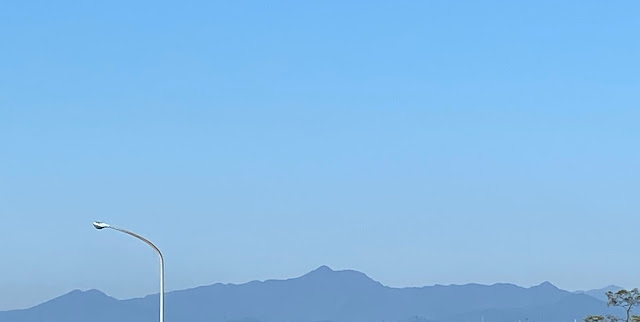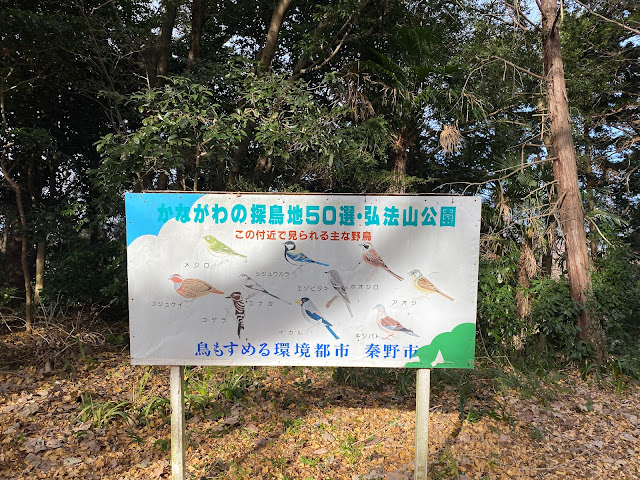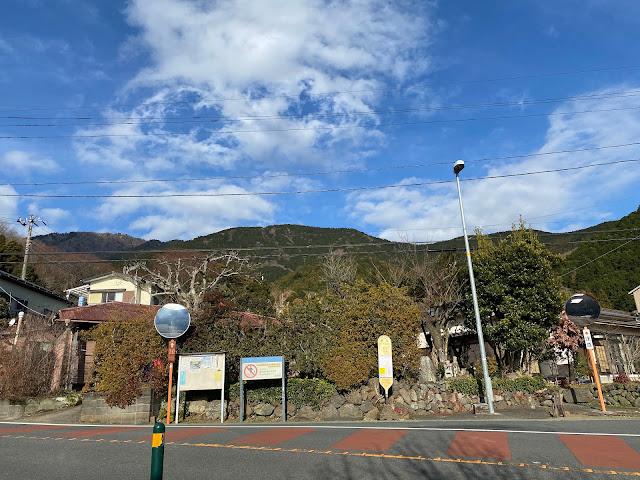Greetings cave visitors. Thank you for dropping by.
I was casting about for a few days trying to decide where to go for a hike. I had a few conditions that I wanted to meet for this hike so it was a bit difficult to choose. I eventually settled on two mountains on the side of Mt. Fuji. Perhaps you know Mt. Hoei 宝永山? That's the bump sticking out on the left side of Fuji when viewed from Tokyo. The two mountains I headed for are just below that. They are usually called some variation of Futatsuka or Futago. Futago means twin.
Mt. Futatsuka in winter
Without further ado, here are the stats and such. Then I'll show some pictures.
Location: Mt. Futatsuka in Gotemba
Starting and stopping point: Umagaeshiue 馬返し上 Fuji Skyline Drive
Mountains climbed:
Futatsukakamiduka ~ Futatsukashimoduka
Getting there/getting around:
Most people take a car or a bus to one of the main parking lots. I took my scooter and parked on the side of the road. In my case, it was a great idea. It's not a spot you could put a car, though. I wouldn't risk putting a large motorcycle there either.
My actual plan was to take my bike to the Gotenba Train Station and take a bus up into the mountains from there. The reason was that I was worried about riding my two-wheeler too far up into the mountains. On the day, though, the weather and road conditions were just so nice that I decided to ride up as far into the mountains as I could and decide whether or not I needed to go back and get the bus. It turned out that I was able to get a fair distance up the Fuji Skyline Drive--not as far as the bus would have brought me-but far enough. It seemed like a good idea to just leave my bike on the side of the road and start from there. That's why I put the quote from Ike in the title. If I hadn't done a fair amount of thinking and planning ahead of time, I wouldn't have been able to react to the situation on the ground the way I did. It turned out that what I ended up doing was better than what I had tentatively planned.
Here're some real-time cameras of roads in the area. Shizuoka cameras
Map: Yama to Kogen Chizu 32 富士山 御坂・愛鷹山 FUJI-SAN MISAKA・ASHITAKA-YAMA
Weather Information: Top of Mt. Fuji 双子山(上二ツ塚)Futatsukakami
Time:
5:18 (minus 37 minutes for lunch)
Distance:
17.2km
Elevation:
Lowest: 1,042m Highest: 1,931m Total Ascent: 1,048m Total Descent: 1,051m
Technical considerations/difficulty:
The southeast side of Mt. Fuji is home to the Gotemba Trail. That trail leaves the treeline soon after the 5th Station and is characterized by black volcanic rock and sand. This part of the mountain is fairly straightforward to navigate. Since almost all of this hike is above the treeline you can see landmarks and destinations from quite a distance. Providing you have clear weather, it's almost impossible to get lost. If you were stuck in bad weather, I can see it could be very possible to get lost on the monotonous terrain.
There are almost no chains to speak of and no ladders or anything of the sort until you get far above where I hiked yesterday. The weather can be a bear. I was on this trail one August and recall being absolutely pelted by rocks blown by the wind. That day a friend and I ventured out to the peak of Mt. Hoei (宝永山) and I thought we would be blown off.
It is actually easier to hike there in the cold than it is in the summer. Your feet sink a little with each step in the black sand in summer. In winter, the surface is firmer and makes for easier walking.
Yesterday, the weather was very pleasant. The wind wasn't that bad and the lowest the thermometer registered was -2 C/28 F at my highest point. I actually hiked much of the day with my down jacket stuffed in my backpack.
I was prepared for colder weather than I got. Another guy I know went to the same place last week and experienced -8 C/17 F. Add a brisk wind 🌬on top of that and 🧊 brrr.
Facilities:
Absolutely nothing at this time of year.
Thoughts/observations/recommendations:
I am so glad I could do this hike and really liked it. If you want to do something similar, the simplest this is to get to the parking lot at Mizugatsuka Park either by car or by bus and hike up from there.
What is the hiking season for Mt. Fuji? If you look at the official climbing site for Mt. Fuji, you can see clearly that you are NOT ALLOWED to go in the offseason. BUT, if you look at this link risk guidelines for the off-season, you can see that hiking in the off-season is allowed if you are prepared.
I hope that clears it up for you.
It reminds me of a section in the Japanese driver's manual about no parking zones. Parking is ABSOLUTELY prohibited in them and will result in a fine--and possibly the confiscation of one or more of your favorite children. That is unless the driver really needed to stop for an important reason. Then it's ok.
Obviously, you must be prepared if you're going to play on Fuji, but you aren't breaking the law when you walk around those threatening signs blocking the trails. But, please, don't go there unless you're prepared. I submit a hiking plan to the authorities whenever I go into the mountains and my iphone would hopefully help them to find me if necessary.
Most of the people I've met on Fuji in the off-season are hikers like me just hiking around the lower peaks but some people do go to the top. Last January I went as far as the 6th Station on the Yamanashi side and encountered some people coming down from the top. They were kitted out like they were in the Himalayas. I know of one guy who climbs to the top nearly every day of the year! He slacked off in January, though. He only climbed it twice then and hasn't made it to the top yet in February. Not for lack of trying this month. He did get partway before turning back one day last week.
Here's what it looked like yesterday:
OK..... here are some pictures
My first glimpse at the twin mountains on my walk up the road to the bus stop at the 5th Station













































































